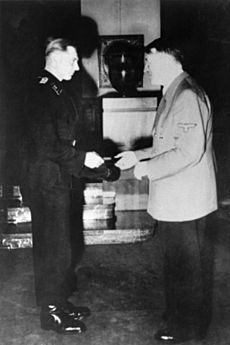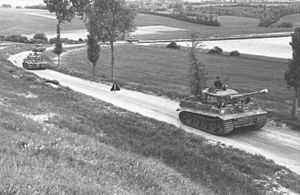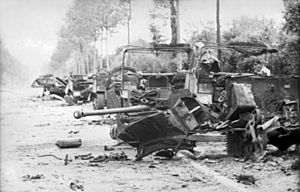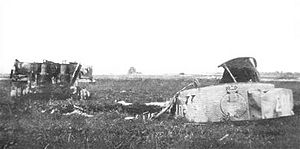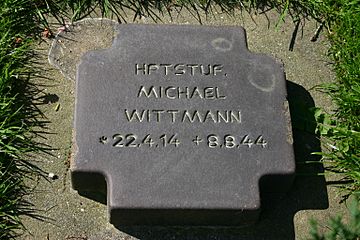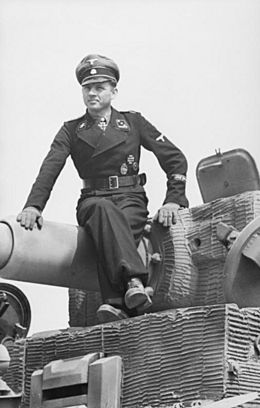Michael Wittmann facts for kids
Michael Wittmann (22 April 1914 – 8 August 1944) was a German tank commander during World War II. He was part of the Waffen-SS, a special military branch of the Nazi Party. Wittmann became famous for a surprise attack during the Battle of Villers-Bocage on June 13, 1944.
In this battle, while driving a Tiger I tank, Wittmann destroyed many enemy vehicles in just 15 minutes. This event was widely shared by Nazi propaganda and made him very well-known. After the war, he became a legendary figure, often called a "panzer ace" (a highly skilled tank commander). Some historians praise his actions, while others question his tactics. He was also known as the "Black Baron."
Quick facts for kids
Michael Wittmann
|
|
|---|---|

Wittmann in 1944
|
|
| Born | 22 April 1914 Vogelthal, Bavaria, German Empire |
| Died | 8 August 1944 (aged 30) near Saint-Aignan-de-Cramesnil, Normandy, German-occupied France |
| Buried |
La Cambe German war cemetery (reinterred)
|
| Allegiance | |
| Service/ |
Heer (1934–1936) Waffen SS (1936–1944) |
| Years of service | 1934–1944 |
| Rank | SS-Hauptsturmführer |
| Unit | SS Division Leibstandarte 101st SS Heavy Panzer Battalion |
| Battles/wars | |
| Awards | Knight's Cross with Oak Leaves and Swords |
Contents
Early Life and Military Service
Michael Wittmann was born on April 22, 1914, in Vogelthal, a village in Bavaria, Germany. In 1934, he joined the German Army. Two years later, in October 1936, he joined the Schutzstaffel (SS), which was a major paramilitary organization of the Nazi Party. He was assigned to the Leibstandarte SS Adolf Hitler (LSSAH) unit.
In 1938, Wittmann took part in Germany's annexation of Austria and the occupation of Sudetenland. He also became a member of the Nazi Party.
Fighting on the Eastern Front
In the spring of 1941, Wittmann's unit moved to the Eastern Front for Operation Barbarossa. This was Germany's plan to invade the Soviet Union. He commanded different tanks, including the StuG III and the Panzer III.
By 1943, he was commanding a powerful Tiger I tank. He became a platoon leader in his unit's heavy tank company. During the Battle of Kursk, one of the largest tank battles in history, Wittmann's platoon helped protect his division. On their first day at Kursk, Wittmann and his crew destroyed eight enemy tanks and seven anti-tank guns.
In November 1943, Wittmann's unit fought against Soviet forces near Zhitomir. His crew destroyed ten T-34 tanks and five anti-tank guns on their first day. By early January 1944, he had destroyed a total of 66 tanks.
Wittmann received the Knight's Cross of the Iron Cross on January 14, 1944. He was later awarded the Knight's Cross with Oak Leaves on January 30 for destroying 117 tanks. Adolf Hitler himself presented him with this award on February 2, 1944.
Battles in Normandy
In April 1944, Wittmann's Tiger Company became part of the SS Heavy Panzer Battalion 101. This battalion was a special unit that could be sent wherever it was needed. Wittmann became the commander of the battalion's second company.
On June 7, the day after the D-Day invasion by the Allies, Wittmann's battalion was ordered to move to Normandy. The journey was long and took five days.
As Allied forces advanced, a gap opened in the German front line near Caumont-l'Éventé. Wittmann's company was sent to protect this weak spot, especially near the town of Villers-Bocage. They arrived late on June 12. His company was not at full strength due to losses and mechanical problems.
The Battle of Villers-Bocage
The next morning, British forces entered Villers-Bocage. Their goal was to take the town and a nearby hill. Wittmann was not expecting them so soon. He decided to act quickly, believing the enemy had already spotted him.
He ordered the rest of his company to stay put and set off with just one tank. Around 9:00 AM, Wittmann's Tiger tank appeared on the main road. He immediately attacked the British tanks on the hill, destroying them.
Wittmann then moved into Villers-Bocage, attacking many transport vehicles parked along the road. He also engaged several light and medium tanks. Other British tanks in the town quickly reacted, but Wittmann continued his attack. He destroyed more tanks, scout cars, and half-tracks.
Accounts differ on what happened next, but Wittmann's tank was eventually disabled by an anti-tank gun. In less than 15 minutes, Wittmann's unit, mostly thanks to him, had destroyed 13 or 14 tanks, two anti-tank guns, and 13 to 15 transport vehicles.
For his actions at Villers-Bocage, Wittmann was promoted and received the Knight's Cross of the Iron Cross with Oak Leaves and Swords. German propaganda quickly gave Wittmann all the credit for the British tanks destroyed. They even created fake images to make the destruction seem larger. This made the British believe the battle was a huge disaster for them.
Wittmann's Death
On August 8, 1944, British and Canadian forces launched Operation Totalize. They captured important high ground near Saint-Aignan-de-Cramesnil. Unaware of why the Allies had stopped, German commander Kurt Meyer ordered a counterattack to retake the high ground.
Wittmann led a group of seven Tiger tanks, supported by other tanks and infantry. As they crossed open ground, they were ambushed by Allied tanks from two sides. British tanks were hidden in woods, and Canadian tanks were positioned behind stone walls.
The German attack failed. Canadian tanks destroyed two Tiger tanks, two Panzer IVs, and two self-propelled guns. British tanks destroyed three other Tigers. During the ambush, anti-tank shells hit Wittmann's tank, causing the ammunition to explode. The tank caught fire, and its turret was blown off.
Wittmann and his crew died in the tank. They were buried in an unmarked grave. In 1983, their burial site was found, and they were reburied together at the La Cambe German war cemetery in France.
Who Destroyed Wittmann's Tank?
There has been much discussion about who was responsible for destroying Wittmann's tank. After the war, several Allied units claimed credit, including Polish, Canadian, and British tank units. Some even thought Allied aircraft might have hit his tank, but this was later disproven.
In 1985, a British veteran named Les Taylor claimed that Joe Ekins, a fellow soldier from the 1st Northamptonshire Yeomanry, destroyed Wittmann's tank. This became a widely accepted story for a while.
However, other historians suggest that a Canadian unit, A Squadron of the Sherbrooke Fusilier Regiment, might have been responsible. They were positioned very close to the German tanks, behind a stone wall. Their firing angle matches the damage found on Wittmann's tank. Due to their close distance, it is believed they were more likely to have destroyed his tank.
Wittmann's Skills as a Commander
Many historians have found Wittmann's actions at Villers-Bocage very impressive. They have called his attack "one of the most amazing engagements in the history of armoured warfare." He is credited with destroying 130 tanks, making him Germany's top tank ace.
However, some military experts have different opinions. Wolfgang Schneider, a German tank commander and historian, believes Wittmann made several mistakes at Villers-Bocage. He points out that Wittmann spread out his forces and advanced alone into the town. Schneider argues that Wittmann's "carefree" advance was "pure folly" and that a better-planned attack could have achieved more. He also suggests that Wittmann's rash actions later cost him his life.
Historian Sönke Neitzel notes that the number of tanks destroyed by highly decorated commanders should be viewed carefully. It is often hard to know exactly who destroyed what in the chaos of battle.
Steven Zaloga, another historian, points out that Wittmann achieved most of his tank kills (120 out of 135) in 1943 on the Eastern Front. At that time, his Tiger I tank had a big advantage in firepower and armor. It was almost impossible to destroy from the front by Soviet tanks. This allowed Wittmann to destroy enemy tanks from a safe distance. Zaloga suggests that many "tank aces" were simply lucky to have such powerful tanks. By 1944, Allied technology had caught up, and the Tiger I was no longer as invincible. Wittmann's death, just two months after moving to France, shows this new reality.
Historian John Buckley has criticized how many historians describe the fighting at Villers-Bocage. He argues that by giving all the credit to Wittmann, they are unknowingly repeating Nazi propaganda.
Awards and Recognition
- Iron Cross (1939)
- 2nd Class (July 12, 1941)
- 1st Class (September 8, 1941)
- Panzer Badge in Silver
- Knight's Cross of the Iron Cross with Oak Leaves and Swords
- Knight's Cross on January 14, 1944
- Oak Leaves on January 30, 1944
- Swords on June 22, 1944
Images for kids
See also
 In Spanish: Michael Wittmann para niños
In Spanish: Michael Wittmann para niños


